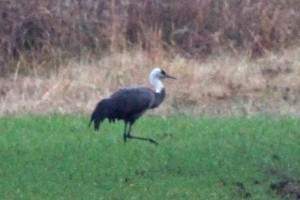Cranes are fly. These big beautiful graceful birds jolt the souls of non-birders and birders alike. At five feet tall, the snow-white adult whooping crane is the tallest bird in North America. The whooper has a red patch on its face and the top of its head. The wingtips are black.
The whooper has been teetering on the brink of extinction for years. Fossilized evidence of whooping cranes dates back to the Pleistocene, when whoopers ranged from Canada to Mexico and from Utah to the Atlantic seaboard. Biologists believe whooping cranes numbered in the tens of thousands when European settlers arrived in North and Central America. Early explorers documented whooping cranes from 35 states in the U. S., six Canadian provinces and four Mexican states. But these big, impressive birds were big targets and over hunting and loss of habitat quickly decimated the population and by 1941 there were only 16 of these majestic birds left in the world.
Today, the population of whooping cranes hovers at around 525 individuals. About 300 of those belong to the only native migratory flock of whoopers in the world that nest in Wood Buffalo National Park in Canada and overwinter at Aransas National Wildlife Refuge on the Texas Gulf coast. There are two non-migratory reintroduced flocks of about 50 birds each in Florida and Louisiana and the last 100 or so are part of the Whooping Crane Eastern Partnership’s (WCEP) efforts to reestablish an eastern migratory flock. The WCEP flock nests in Necedah National Wildlife Refuge in Wisconsin and overwinters in Florida.
North Carolina birders got a thrill this year when a pair of WCEP whoopers took up residence in December, in Clay County. As word of the presence of these visitors spread the U.S. Fish & Wildlife Service issued a press release asking birders and other onlookers to respect the birds’ privacy so they can go about their daily routine without being disturbed. The agency asks that onlookers not approach closer than 600 feet by foot and/or 300 feet by vehicle and if possible to remain in your vehicle when viewing the birds. I am sure they don’t want a replay of 2004 when a group of whoopers migrating back to Necedah made a stopover in Macon County and curiosity seekers got too close flushing the birds and causing one to fly into a power line. The bird apparently wasn’t injured and was able to continue its flight but it was a close call that could have been easily avoided.
Continue farther west and the 2011 crane jazz gets even jazzier. Hiwassee Refuge near Birchwood in southeastern Tennessee is a well-known winter haven for thousands of sandhill cranes and since the WCEP started its eastern project whoopers have regularly stopped over at Hiwassee. Then, this December about the same time whoopers were spotted in Clay County, Nc. an even rarer sight appeared at Hiwassee – a Hooded Crane. The hooded crane is an Asian species, that nests in northern China and southeastern Russia. Most hooded cranes winter in southern Japan, a few winter in China and Korea.
Any way you map it, a wild hooded crane showing up in the States under its own power is one, really stray bird. Some private collectors in the States have hoodeds, as do some zoos and it will be left to rare bird committees and the American Birding Association to decide if this hooded crane will be classified as a wild – therefore “countable” bird for all the listers out there who have traveled from more than a dozen states to get a glimpse.
But even if it’s not countable, as the whoopers aren’t because they are from a captive population, there is nowhere else in the world where you can go to see a hooded crane, whooping cranes and sandhill cranes standing wingtip to wingtip in the wild.
And it came at a great time for the Tennessee Wildlife Resources Agency, Hiwassee Refuge and its supporters as they prepare for their annual free Sandhill Crane Festival on Jan. 14-15.

